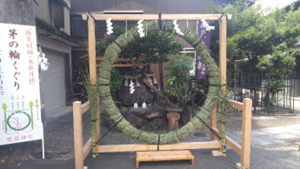Natsukoshi-no-harae Shrine’s June Event Chinowa Kuguri II ~Gotainomiura~
Yoshie Doi
 |
 |
 |
Taken on June 20, 2023 Hanjo Shrine2
There was a fortune-telling that began in the Nara period called “Gotai no Miura”. It is a ceremony held in June and December to tell whether the emperor’s health is well or not. The eight Urabe and Miyaji, who are made up of fortune-telling experts, are exclusive fortune-tellers for the Emperor and Crown Prince. They can tell fortunes by how the tortoise shell cracks. It’s the top secret of the palace.
Hold the shell vertically, apply fire to the machikata (the line in the middle of the shell), and pour water to create cracks. If it cracks along the direction of the machikata, it is good luck, and if it spreads like a branch, it is bad luck. It was also a ceremony to spend a peaceful time so that the emperor’s health would not be disturbed.
In the era of Emperor Jito, in the latter half of the 7th century, when many emperors died due to the curse of the gods, it was held as a ritual to prevent the curse of the gods. Although it is described in “Kokoshui“, the actual situation is not well understood.
From June 1st to June 10th, gotainomiura is performed, and on the 11th, Jinkonjiki is said.
On the nights of the 11th day of the 6th month of the lunar calendar and the 11th day of the 12th month of the 6th month of the lunar calendar, they invoked Amaterasu Omikami, there was also a ceremony in which the emperor himself made an offering by changing the kind of fire and offering freshly cooked rice. Then, on June 30th, a Harae ceremony was held.
Jinkonjiki is unlike the Niinamesai, this event uses old rice. As a result of various fortune-telling, the direction of the curse etc. was indicated, and there was an idea that life would be renewed and refreshed by cooking rice with a new kind of fire and offering it. In ancient Japan, there were 6 months in a year. There are 12 months now, but in fact, June was also the end of the year. That is why June and December are the months of purification. As for renewing the fire, it is also a Japanese custom to get a new fire and boil it at the year-end and New Year holidays, which can be seen at Yasaka Shrine.
Chinowa Kuguri, which continues today, also has the same meaning of resetting and purification of the year, so I introduced it.
The end of document
